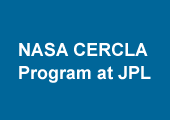
Para Más Información En Español, llame a
Angel Castillo, NASA JPL, Teléfono (818) 354-1585.
|
|
PFAS and Drinking Water Regulatory Update
In April 2024, the Environmental Protection Agency (EPA), under the Safe Drinking Water Act, established a national, legally enforceable drinking water standard for five individual Per- and Polyfluoroalkyl Substances (PFAS) and a Hazard Index (HI) level for two or more of four PFAS as a mixture. The limits are known as maximum containment levels (MCLs) - the highest level of the contaminant that is allowed in drinking water. The MCL is set to be protective of human health.
The new federal drinking water regulation requires all public water suppliers to determine whether PFAS is in their drinking water by testing for 29 PFAS, and to take action such as notifying consumers, and reducing the levels to below the drinking water standards. Public water suppliers have three years to complete initial monitoring for these chemicals, and those that detect PFAS above the new standards will have five years to implement solutions to reduce PFAS in their drinking water to meet the MCLs.
In the lead up to EPA’s April announcement, some states have worked to reduce PFAS in drinking water through state-specific initiatives. Since January 2020, California has had non-regulatory, health-based advisory notification and response levels for four PFAS: PFOS, PFOA, PFBS, and PFHxS. When levels are exceeded, water suppliers in the state must notify consumers and/or respond by taking the water source out of service or provide treatment. PFAS have not been detected above State notification levels in the Monk Hill Treatment System in Pasadena or the Lincoln Avenue Water Company (LAWC) wells.
Under the new federal regulations, public water suppliers are required to meet the established MCLs. States can develop their own standards but those cannot be less protective of human health than the federal levels. California adopted non-enforceable Public Health Goals (PHG) for PFOA and PFOS in drinking water in April 2024. These advisory levels are lower than the federal MCLs and lower than can be reliably measured. They will be used to guide the development of the State’s PFAS drinking water standards.
JPL Groundwater Cleanup Treatment Technologies Also Treat PFAS
Water treatment technologies that remove PFAS from drinking water exist, are in use today, and more are being developed. Two technologies shown to be effective in removing various PFAS from groundwater are liquid phase granular activated carbon (LGAC) and ion exchange (IX).
Both technologies are already in place at the three NASA-funded groundwater treatment plants and have been shown to be effective in removing certain PFAS from groundwater. One treatment plant is located on JPL property; another plant is in Altadena operated by the Lincoln Avenue Water Company (LAWC); and a third plant is operated by the City of Pasadena. These technologies have been effectively removing perchlorate and volatile organic compounds (VOCs) from groundwater as part of the groundwater cleanup program at JPL. The technologies can remove PFAS to the new drinking water standard.
In addition, NASA’s 25 monitoring wells on and in the vicinity of JPL are effective in detecting chemicals in groundwater. NASA routinely conducts sampling for several chemicals including PFAS. Quarterly monitoring reports are posted here. NASA’s latest Five Year Review - a technical assessment required for the duration of the cleanup, determined the JPL groundwater cleanup program is performing well and continues to be effective and protective of human health and the environment. The treatment systems enable LAWC and the City of Pasadena to provide their customers with a continuous supply of drinking water that meets all State and federal clean drinking water standards.
PFAS Investigation Update
NASA is committed to understanding and addressing per- and polyfluoroalkyl substances (PFAS) at the Jet Propulsion Laboratory. The investigation began in 2019 to understand historical use, storage, and possible release of PFAS-containing materials to the environment. A preliminary assessment was conducted as a part of a NASA-wide proactive approach to understand and address this emerging contaminant. Results identified five locations at JPL as potential PFAS source areas: an area where AFFF (aqueous film forming foam) was historically stored and released, and four areas where PFAS-containing material may have been used and disposed of. A fact sheet about PFAS and NASA’s efforts may be seen here.
In August 2022, EPA proposed the designation of two PFAS as hazardous substances and requested the PFAS investigation at JPL be considered part of NASA’s Comprehensive Environmental Response, Compensation, and Liability Act (CERCLA) groundwater cleanup program. NASA agreed and moved PFAS related documents to the Administrative Record and this website. In late April 2024, EPA finalized designating PFOS and PFOA as hazardous substances and has proposed that seven more PFAS be designated along with requirements for their cleanup.
Since the initial investigation, NASA has been conducting further site investigation activities including groundwater and soil sampling in the five potential source areas a JPL. The samples’ results were evaluated by comparing them to EPA’s PFAS regional screening levels (RSLs) and California notification levels for groundwater and soil. In July 2023, a Draft Site Inspection (SI) Report was submitted to EPA and after responding to comments, NASA submitted the Final SI Report to regulators in late October. The report indicated PFAS were present at concentrations slightly above screening levels in a few groundwater and soil samples. NASA subsequently conducted additional groundwater monitoring. The additional groundwater monitoring results will be reviewed along with all that is known about the site hydrology and geology, any potential exposure pathways, and the existing remedies in place to determine the need for any next steps.
NASA is following the many developments regarding PFAS and will continue to conduct the investigation using the latest scientific information and regulatory requirements.
|